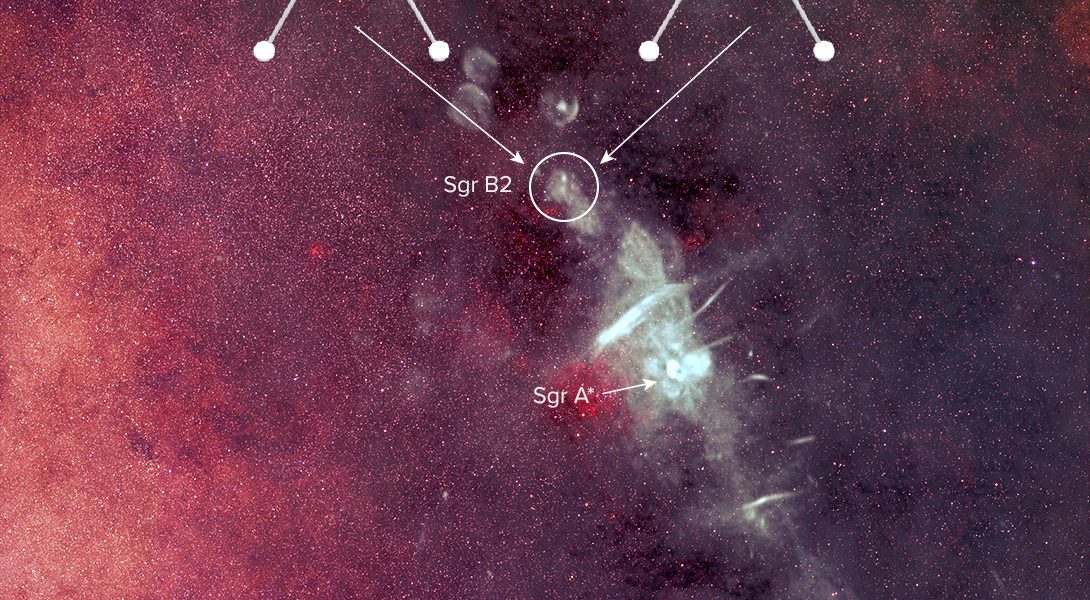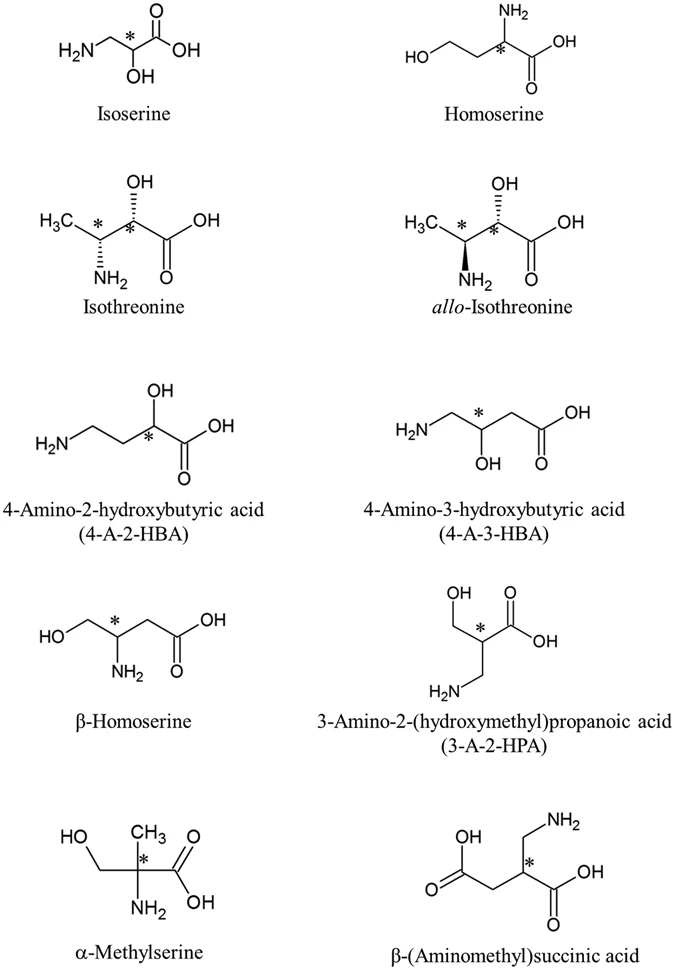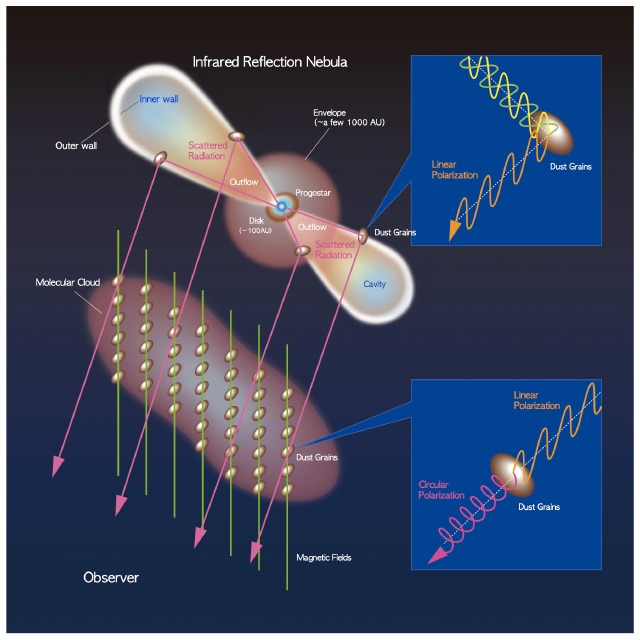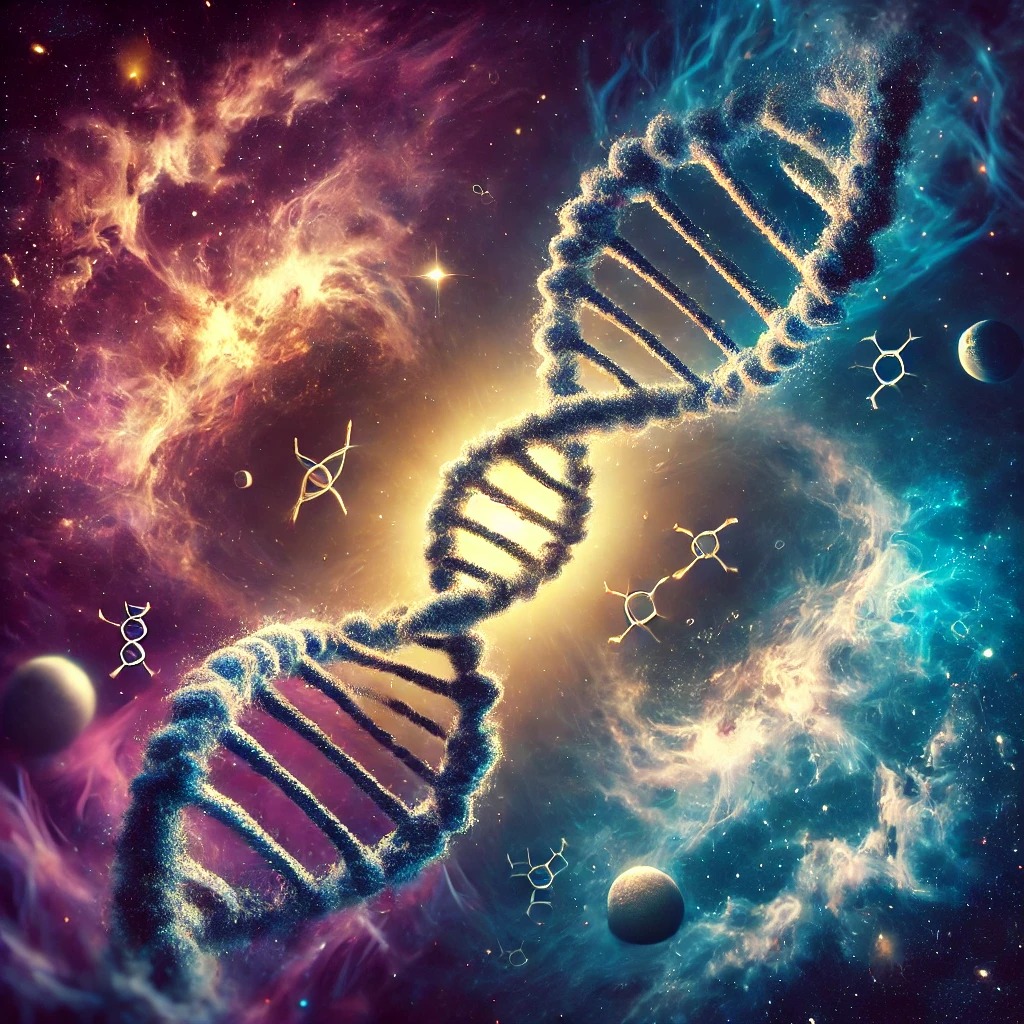Introduction
Chirality, the property of asymmetry where an object is not superimposable on its mirror image, is a fundamental concept in chemistry and biology. It plays a crucial role in the structure and function of biological molecules, influencing everything from the way drugs work to the taste and smell of foods. But chirality is not confined to Earth – it also manifests in space, offering intriguing clues about the origins of life. This blog explores the presence of chiral molecules in interstellar space and meteorites, theories on the origin of biological chirality, and the implications for astrobiology and the search for extraterrestrial life.

The two mirror-image enantiomers of the amino acid alanine.
Chirality in Interstellar Molecules and Meteorites
Discovery of Chiral Molecules in Space
The detection of chiral molecules in space has been a groundbreaking development in astrochemistry. Using advanced spectroscopic techniques, scientists have identified chiral molecules in various cosmic environments. For example, the amino acid glycine, which can exist in both left- and right-handed forms, has been detected in the interstellar medium. These findings are significant because they suggest that the building blocks of life, including chiral molecules, may have formed in space and were delivered to Earth via meteorites and comets.
Case Studies:
Meteorites and Interstellar Medium
One of the most compelling pieces of evidence for the presence of chiral molecules in space comes from the analysis of meteorites. The Murchison meteorite, which fell in Australia in 1969, contains over 70 different amino acids, including several that are chiral. Notably, an excess of left-handed (L) amino acids has been observed, suggesting that some process in space favored the formation of one chirality over the other. Similarly, studies of molecular clouds, the dense regions of gas and dust where stars and planets form, have revealed the presence of chiral molecules, further supporting the idea that these compounds are widespread in the cosmos.

Life’s First Handshake: Chiral Molecule Detected in Interstellar Space
Chirality in Space, a Helping Hand to Biology on Earth
Every living organism on Earth exclusively uses one specific handedness of various chiral molecules, a trait known as homochirality. This characteristic is essential for life and has significant implications for biological structures like DNA’s double helix. The origins of why life relies on one specific handedness remain a mystery to scientists. Researchers suggest that the answer might lie in how these molecules naturally form in space before becoming part of asteroids and comets, which later deliver them to young planets. Meteorites in our Solar System contain chiral molecules that predate Earth, and recently, chiral molecules have been found in comets as well. “These small celestial bodies may have influenced the development of the handedness observed in life today.” Discovering a chiral molecule in space provides an opportunity to study the formation processes of these molecules before they are incorporated into meteorites and comets, offering insights into their role in the origins of homochirality and life. Propylene oxide, one of the most complex and structurally intricate molecules detected in space to date, represents a significant discovery. “This detection paves the way for further research to determine how and where molecular handedness arises and why one form might be slightly more prevalent than the other.”
A chiral molecule in interstellar space – Propylene Oxide
Astrochemists detect chiral molecules in Interstellar Space for the first time. Astrochemist McGuire and his team have reported in Science the discovery of a chiral molecule in interstellar space. The compound, propylene oxide, was found in Sagittarius B2, a cloud of gas and dust near the center of the Milky Way. This discovery suggests that chiral molecules existed long before solar systems. If these molecules were predominantly right-handed, they might have influenced the formation of other right-handed molecules, including DNA, well before the formation of our sun. This could imply that the right-handed excess was intrinsic to Earth’s chemistry as it formed, rather than being delivered by meteors later. This finding hints that some of the complex chemistry associated with life may exist elsewhere in the universe. However, some biochemists who study chiral molecules in meteorites caution that linking these observations directly to DNA chirality is challenging. The processes that occur between molecular clouds and the emergence of life remain unclear. Current tests aim to determine whether most of the propylene oxide molecules are right- or left-handed.

Chiral Forms of Propylene Oxide
This diagram illustrates the chiral nature of propylene oxide, showing its left-handed and right-handed forms, which are non-superimposable mirror images. The lower part of the image demonstrates the mismatches that occur when attempting to superimpose these two forms. This chiral property of molecules is crucial for understanding their behavior and interactions in biological systems and in space, where chiral molecules like propylene oxide have been detected for the first time.
Extraterrestrial amino acids in the Murchison meteorite
The discovery of extraterrestrial organic compounds is crucial for understanding prebiotic organic synthesis in the universe. Amino acids, in particular, have been examined in carbonaceous meteorites for nearly five decades. This study reveals the identification of ten new amino acids in the Murchison meteorite, including a novel group of nine hydroxy amino acids. The predominance of C3 and C4 hydroxy amino acid isomers offers insights into the extraterrestrial synthesis mechanisms of organic compounds. An additional experiment indicates that these compounds might form from aldehydes and ammonia on the meteorite’s parent body. This research suggests that mechanisms other than the Strecker reaction, previously proposed as the primary synthetic pathway for amino acids, could contribute to their formation in meteorites.

Chiral Hydroxy Amino Acids Discovered in the Murchison Meteorite
This image illustrates the structures of newly identified chiral hydroxy amino acids found in the Murchison meteorite. These amino acids, including isoserine, homoserine, isothreonine, allo-isothreonine, and various hydroxybutyric acids, demonstrate significant structural diversity. Their presence supports the hypothesis that amino acids in meteorites can form through complex chemical pathways, expanding our understanding of prebiotic organic synthesis in extraterrestrial environments. source:
Theories on the Origin of Biological Chirality
Homochirality in Life
Homochirality, the uniform chirality of biological molecules, is a defining feature of life on Earth. For example, amino acids in proteins are almost exclusively left-handed, while sugars in DNA and RNA are right-handed. This uniformity is crucial for the proper functioning of biological molecules, as it allows for the specific interactions needed for processes like enzyme catalysis and DNA replication. The origin of homochirality is a central question in the study of life’s origins, with several competing theories vying to explain how this asymmetry arose.

Three-dimensional structure of the RNA molecule and its mirror image.
The helical shape of nucleic acids is influenced by the chemical chirality of their sugar backbone. In nature, nucleic acids contain right-handed sugars (D-ribose in RNA and D-deoxyribose in DNA), leading to a naturally right-handed helical structure. Conversely, in a hypothetical mirror world, nucleic acids would consist of left-handed sugars (L-ribose or L-deoxyribose), resulting in a left-handed helical structure. Although DNA and RNA-based life as we know it utilizes one specific chirality, referred to as “live,” an alternative form, termed “evil,” could have evolved independently, making analogous evolutionary adaptations in similar environmental conditions.
Hypotheses on the Emergence of Homochirality
Several theories have been proposed to explain how chiral molecules form in space. One hypothesis involves the influence of circularly polarized light, which can induce an excess of one enantiomer over the other through asymmetric photolysis. Laboratory experiments have demonstrated that circularly polarized light can break bonds in chiral molecules more efficiently on one side, leading to an imbalance in chirality. Another theory suggests that weak nuclear forces, which are inherently chiral, could influence the formation of chiral molecules during the early stages of chemical evolution. Once a small excess of one chirality was established, autocatalytic reactions could have amplified this imbalance, leading to the homochirality observed in biological systems today. Computer simulations and laboratory experiments continue to explore these mechanisms, providing valuable insights into the origins of cosmic chirality.

Polarization Patterns in Star-Forming Regions
This diagram illustrates how light scattering by dust grains in star- and planet-forming regions like the Cat’s Paw Nebula creates polarization. Linear polarization occurs due to aligned dust grains in magnetic fields, while circular polarization arises from light scattering in these dusty environments. Such polarization can lead to the homochirality observed in biological molecules on Earth, suggesting an extraterrestrial origin influenced by polarized light in space.
No homochirality, no life
With the presence of both stereoisomers, RNA polymerization is not possible. According to Blackmond, the saying “no homochirality, no life” holds true so far. A significant challenge is enantiomeric cross-inhibition, humorously referred to by Gerald Joyce as biology’s “original syn.” This cross-inhibition arises because nucleic acids begin polymerization by matching base pairs. Incoming monomers attach to the backbone with each sugar and base configured anti to each other. If a monomer with an oppositely handed sugar is present, it must add with its base in the syn configuration to both base-pair and bond to the backbone, creating a conformation that prevents further polymerization.

Mechanism of Homochirality in Prebiotic Chemistry
This highlights why only single-handed chemistry can create biological polymers like RNA, and how opposite-handed molecules obstruct their assembly. It turns out that when only one chiral form is present, the chemical copying mechanism operates smoothly. However, problems arise when building blocks of both chirality are present, as they essentially poison each other’s polymerization process.
Experimental Evidence and Simulations
Experimental evidence supports several of these hypotheses. For example, experiments using circularly polarized light have demonstrated the preferential destruction of one enantiomer over the other in amino acids. Similarly, studies of chiral autocatalysis have shown how small initial imbalances in chirality can be amplified through chemical reactions. Computer simulations have also been used to model the emergence of homochirality, providing insights into the conditions and mechanisms that could have led to this fundamental property of life. These experiments and simulations are crucial for testing and refining theories about the origin of biological chirality.
Implications for Astrobiology and the Search for Extraterrestrial Life
Chirality as a Biosignature
The detection of chiral molecules on other planets and moons could serve as a strong biosignature, indicating the presence of life or prebiotic chemistry. Chirality is a hallmark of biological processes, and finding an excess of one enantiomer over the other in extraterrestrial samples would suggest that similar processes might be occurring elsewhere in the universe. Current and future missions are equipped with instruments designed to detect chiral molecules, such as the Mars rovers and the upcoming Europa Clipper mission.
Potential for Life Beyond Earth
Several environments in the solar system and beyond are considered promising for the search for chiral molecules and, by extension, extraterrestrial life. Mars, with its history of liquid water, is a prime target. The detection of organic molecules by the Curiosity rover has already provided tantalizing clues, and future missions will focus on analyzing the chirality of these compounds. Europa, one of Jupiter’s moons, has a subsurface ocean that could harbor life. The Europa Clipper mission will carry instruments capable of detecting chiral molecules in the moon’s icy surface and plumes.
Philosophical and Scientific Implications
The discovery of chirality beyond Earth would have profound implications for our understanding of life and its universality. It would suggest that the principles governing biological chirality on Earth are not unique, but rather a common feature of life in the universe. This raises philosophical questions about the nature of life and the possibility of a universal biology. Scientifically, it would provide valuable insights into the processes that led to the emergence of life on Earth and guide the search for life elsewhere.
Conclusion
Chirality, a fundamental property of molecules, plays a crucial role in the chemistry of life. Its presence in interstellar space and meteorites provides important clues about the origins of life on Earth and the potential for life elsewhere in the universe. Theories on the emergence of biological chirality, supported by experimental evidence and simulations, offer insights into how life’s homochirality might have arisen. As we continue to explore the cosmos, the detection of chiral molecules will be a key indicator in the search for extraterrestrial life, potentially answering some of the most profound questions about our place in the universe.
Suggested Further Readings
Devínsky, F. Chirality and the Origin of Life. Symmetry 2021, 13, 2277. https://doi.org/10.3390/sym13122277
Y. Ellinger, F. Pauzat, A. Markovits, A. Allaire and J.-C. Guillemin, The quest of chirality in the interstellar medium I. Lessons of propylene oxide detection, Astronomy & Astrophysics, 633, A49 (2020). https://doi.org/10.1051/0004-6361/201936901
Bailey, J. (2001). “Astronomical Sources of Circularly Polarized Light and the Origin of Homochirality.” Origins of Life and Evolution of the Biosphere, 31(1-2), 167-183.
The Astrophysical Journal Letters, 895:L11 (14pp), 2020 May 20 https://doi.org/10.3847/2041-8213/ab8dc6; https://iopscience.iop.org/article/10.3847/2041-8213/ab8dc6/pdf
Cronin, J. R., & Pizzarello, S. (1997). “Enantiomeric Excesses in Meteoritic Amino Acids.” Science, 275(5302), 951-955.
Koga, T., Naraoka, H. A new family of extraterrestrial amino acids in the Murchison meteorite. Sci Rep 7, 636 (2017). https://doi.org/10.1038/s41598-017-00693-9
Glavin, D. P., & Dworkin, J. P. (2009). “Enrichment of the Amino Acid L-Isovaline by Aqueous Alteration on CI and CM Meteorite Parent Bodies.” Proceedings of the National Academy of Sciences, 106(14), 5487-5492.
Meierhenrich, U. J. (2008). Amino Acids and the Asymmetry of Life: Caught in the Act of Formation. Springer.
Pizzarello, S., & Weber, A. L. (2004). “Prebiotic Amino Acids as Asymmetric Catalysts.” Science, 303(5661), 1151.
Quack, M. (2002). “How Important is Parity Violation for Molecular and Biomolecular Chirality?” Angewandte Chemie International Edition, 41(24), 4618-4630.
Soai, K., Shibata, T., Morioka, H., & Choji, K. (1995). “Asymmetric Autocatalysis and Amplification of Enantiomeric Excess of a Chiral Molecule.” Nature, 378(6559), 767-768.Vester, F., & Ulbricht, T. L. V. (1959). “The Effect of Circularly Polarized Light on the Absolute Configuration of Optically Active Molecules.” Tetrahedron, 5(1), 235-240.
Watanabe, K., & Kato, M. (2004). “Homochirality Originating from Two Types of Enantiomeric Impacts of Circularly Polarized Light.” Journal of the American Chemical Society, 126(19), 5674-5675.
Wolfe, R. S., & Wells, M. J. (1980). “Biological Significance of the Chirality of Phospholipids.” Biochimica et Biophysica Acta (BBA) – Biomembranes, 600(1), 29-38.
Blackmond DG. The origin of biological homochirality. Cold Spring Harb Perspect Biol. 2010 May;2(5):a002147. doi: 10.1101/cshperspect.a002147. Epub 2010 Mar 31. PMID: 20452962; PMCID: PMC2857173.
Kwon, J. Near-Infrared Circular Polarization Images of NGC 6334-V 2013, Astrophysical Journal Letter 765, L 6. iopscience.iop.org/2041-8205/765/1/L6/
Other Blogs on #ChiralityonFriday
1. Introduction to Chirality: Understanding the Basics
2. Molecular Handedness: How Chirality Shapes Molecules
3. Chirality in Nature: From DNA to Snail Shells
4. The Chemistry of Taste and Smell: How Chirality Affects Senses
5. Chiral Chemistry in Everyday Life: Hidden Handedness Around Us
6. Chirality in Pharmaceuticals: The Impact of Molecular Handedness on Medicine
7. https://chiralpedia.com/blog/chirality-in-materials-science-designing-with-handedness/
8. Chirality in Space: Cosmic Asymmetry and the Origins of Life
9. The Future of Chirality: Innovations and Emerging Trends
10. Chirality and You: Understanding and Appreciating Molecular Handedness


In our regular walk of life, we often ignore this significance of chirality in space. This article brings to light several of those elements to incite our curiosity. Thanks for your efforts in compiling all the relevant information sir.
Excellent sir, a very good compilation of how chirality impacts the life on planets through some wonderful examples of compounds like amino acids present in the meteorites, I appreciate your efforts and intent to come out with a very useful and informative content on chirality and nature, your efforts are really admirable, keep posting your ideas and viewpoints for us as always, thank you professor,